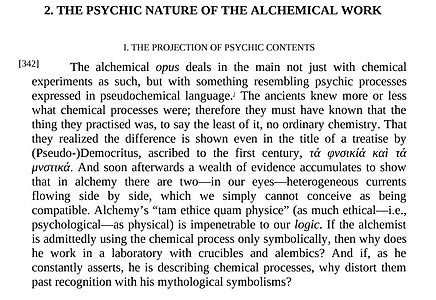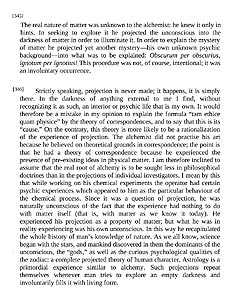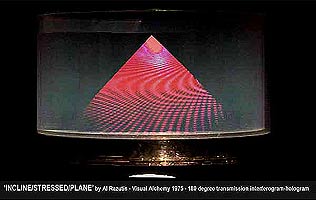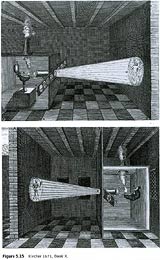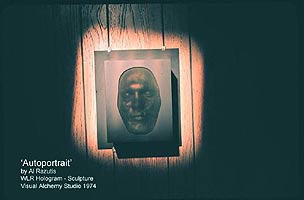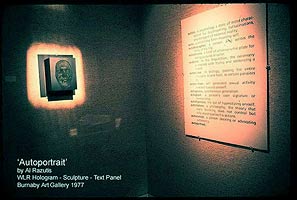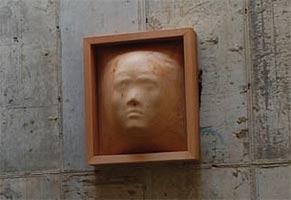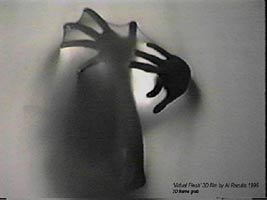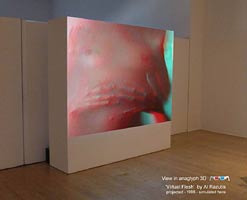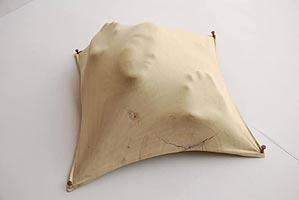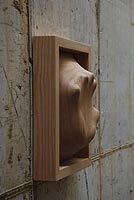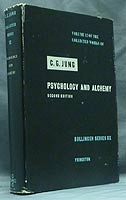Alchemy, Visual Alchemy and their Respective Arts
Essay by Al Razutis, 2020
Essay on alchemy, visual alchemy, and Psychology and Alchemy by CG Jung, reviewing the origins of holographic works and their purposes at the Vancouver studio Visual Alchemy and the resulting exhibition of these works in Canada and Seattle in the 1970's.
Related page: Visual Alchemy - Theory & Practice
Origins of 'visual Alchemy'
"The 'history' page reads as follows:
"VISUAL ALCHEMY was created in 1972 (& expanded onwards), in Vancouver, Canada by Al
Razutis to function as a personal and services-for-hire multi-media innovations studio for the production of experimental art work in the various emerging medias of the time: experimental/avant-garde film, video art, and holography. The cross-disciplinary activities at this new studio continued some of the "Intermedia" inspired activities which Razutis had participated in the late 1960's. Initially several artists from 'the Grange' (which had occupied a similar location) thought of it as a 'co-op', but after the first phone bills were paid by Razutis, that idea was discouraged and never re-appeared."
"That's hardly the whole story, and leaves out all of the 'intentions'...
"So, let's examine the 'alchemy', the 'visual alchemy' and see what it meant."
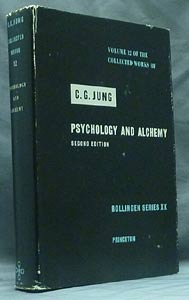
"If there was one book, source of inspirations that was present at my 'Visual Alchemy' Vancouver studio 1970's it was the book "Psychology and Alchemy" by CG Jung.
"I acknowledge this fact because I will make references to alchemy, alchemical works or symbolism from time to time and because this text is available on the web for anyone to read.
It is useful to recall what CG Jung said in referring to the Opus and alchemy and the projection of psychological characteristics onto the work and the transformation.
"[342] The alchemical opus deals in the main not just with chemical experiments as such, but with something resembling psychic processes expressed in pseudochemical language.1 The ancients knew more or less what chemical processes were; therefore they must have known that the thing they practised was, to say the least of it, no ordinary chemistry.
"[345]...The real nature of matter was unknown to the alchemist: he knew it only in hints. In seeking to explore it he projected the unconscious into the darkness of matter in order to illuminate it. In order to explain the mystery of matter he projected yet another mystery - his own unknown psychic background - into what was to be explained: Obscurum per obscurius, ignotum per ignotius! This procedure was not, of course, intentional; it was an involuntary occurrence." (CG Jung)
For our reference (26 mB free download):
Visual Alchemy Art History Photos Only
Visual Alchemy Art History Photos Only
"I'm not pitching a product, but an understanding".
[317] "It goes without saying that there are good and bad authors in alchemical literature as elsewhere. There are productions by charlatans, simpletons, and swindlers. Such inferior writings are easily recognized by their endless recipes, their careless and uneducated composition, their studied mystification, their excruciating dulness, and their shameless insistence on the making of gold. Good books can always be recognized by the industry, care, and visible mental struggles of the author."
-- C.G. Jung, Psychology And Alchemy 2nd Edition, pdf [ page number ] from this source:
Holographic Art History Photos Only
PRIMA MATERIA

"Let's talk some basics."
'Prima Materia (Invisible Section)' by Al Razutis 1974-1975
Reflection hologram collage / assemblage with text. Dimensions 36" x 36" x 4"
Collage / layers of holograms, laminated in clear epoxy, on glass and mirror.
Text etched on glass (1975) - the text will appear in 1979 'Notes on the Art of Holography' by Razutis for Franklin Institute catalog 'New Spaces' exhibition.
http://www.alchemists.com/visual_alchemy/holo_visual.html#primamateria
"prima materia = light" -- for a visual alchemist, or a electromagnetic wave (not a mechanical wave like sound) in a universe of 'ether', which is of course a metaphor not a sci fact, like the interferometers of Michaelson & Morley having confirmed that light speed is constant and propagated in a vacuum without ether. Einstein of course famously related mater and energy and that speed of light in a simple equation. But paradoxes abound, like entanglement, like action at a distance. The twin slit experiment of Young confirmed the twin nature of photons, electrons, and all wave energy to contain its particle twin. And then there is something called quantum connectedness / 'entanglement' and a new holography dedicated to that..." (AR)
"What is a hologram? Well it's a recording of such facts as the ones cited above. We cover this subject by description, example and photos, videos so there is no need to repeat it here.
"What does Jung say about prima materia and medieval alchemists? See if you can read between the lines and apply it to here, and apply it to now." (AR)
![(page 319) -- C.G. Jung, Psychology And Alchemy
2nd Edition, pdf [ page number ] from this source:
https://www.jungiananalysts.org.uk/wp-content/uploads/2018/07/C.-G.-Jung-Collected-Works-Volume-12_-Psychology-and-Alchemy.pdf](images/0-alchemy3-med.jpg)
4. THE PRIMA MATERIA -- I. SYNONYMS FOR THE MATERIA
[425] "The basis of the opus, the prima materia, is one of the most famous secrets of alchemy. This is hardly surprising, since it represents the unknown substance that carries the projection of the autonomous psychic content. It was of course impossible to specify such a substance, because the projection emanates from the individual and is consequently different in each case. For this reason it is incorrect to maintain that the alchemists never said what the prima materia was; on the contrary, they gave all too many definitions and so were everlastingly contradicting themselves. For one alchemist the prima materia was quicksilver, for others it was ore, iron, gold, lead, salt, sulphur, vinegar, water, air, fire, earth, blood, water of life, lapis, poison, spirit, cloud, sky, dew, shadow, sea, mother, moon, dragon, Venus, chaos, microcosm (fig. 162). Ruland's Lexicon gives no less than fifty synonyms, and a great many more could be added.
[426] Besides these half chemical, half mythological definitions there are also some philosophical ones which have a deeper meaning."
"The mercurial dragon of Greek alchemy, surnamed ( ..... ) gave rise to descriptions of the prima materia as Unum, Unica Res, and Monad and to the statement in the "Liber Platonis quartorum" that man is well qualified to complete the work because he possesses that which is simple, i.e., the soul. Mylius describes the prima materia as the elementum primordiale. It is the "pure subject and the unity of forms," and in it any form whatsoever may be assumed (in quo retinetur quaelibet forma cum possibilitate).
[428] In the second version of the Turba, Eximindus says: I make known to you, ye sons of the doctrine, that the beginning of all creatures is a certain primary everlasting and infinite nature which cooks and rules everything, and whose active and passive [aspects] are known and recognized only by those on whom the knowledge of the sacred art has been bestowed.
[429] In Sermo IX of the Turba "Eximenus" puts forward a theory of creation that corresponds to the Biblical one (creation through the "Word") but stands in flagrant contradiction to the above, according to which the beginning is a natura perpetua et infinita. In the Rosarium the prima materia is called radix ipsius (root of itself). Because it roots in itself it is autonomous and dependent on nothing."
(page 319)
-- C.G. Jung, Psychology And Alchemy
2nd Edition, pdf [ page number ] from this source:
https://www.jungiananalysts.org.uk/wp-content/uploads/2018/07/C.-G.-Jung-Collected-Works-Volume-12_-Psychology-and-Alchemy.pdf
Added note:
"If we consider 'light' as prima materia, then it can be decomposed, re-presented, as both a 'solid' (particle) and a 'phantom' (wave). The range of subject matter to accomplish these experiments and expressions are like the range of food one wants to serve at a banquet." (AR)
WHAT IS VISUAL ALCHEMY
"The obvious question, and the answer"

"What is 'Visual Alchemy'? I posed as a question pertaining to my usage of the term.
'It is an 'alchemical theatre'...
The answer is not a riddle, not a hermetic phrase. The answer is not circular, but explained on this page.
Calling it 'Alchemical Theatre' as I did in 1977 for the Visual Alchemy exhibition catalog is further explained now in 2020...
NOTE TO THE WISE and those free with their ideas:
At this point, words take on multiple meanings.
'Visual' can take any number of forms.
'Alchemical' can feature puns, contradictions, and 'Al's chemical (chymical) meanings'.
After all, it's a theatre,
and at this point I remind you of a very important quality,
'this theatre was not created to be art',
but it was exhibited as such, in galleries in museums in history.
THE OPUS
"So what is the 'work'? How does it start?"
"And why are we NOT making 'gold', or 'making money for rich cilents', like some cool 'holo displays' or 'special effects' for Disney or some filthy rich guy living in a European chalet who 'wants more gold' and some 'cool images'?
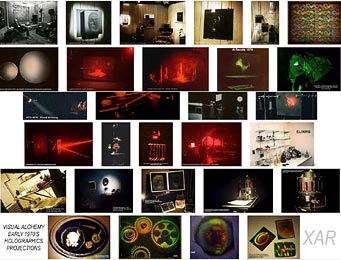
"Because our purpose, and our art, is elsewhere (from making money, or turning crap into 'gold') we have to look into the psychology of this endeavor, this 'work', this opus. This is CG Jung on the psychic nature of the alchemical work, because after all he was a psychologist and he studied the arts." (AR)
2. THE PSYCHIC NATURE OF THE ALCHEMICAL WORK -- I. THE PROJECTION OF PSYCHIC CONTENTS
[342] "The alchemical opus deals in the main not just with chemical experiments as such, but with something resembling psychic processes expressed in pseudochemical language.1 The ancients knew more or less what chemical processes were; therefore they must have known that the thing they practised was, to say the least of it, no ordinary chemistry."
"[345]"...The real nature of matter was unknown to the alchemist: he knew it only in hints. In seeking to explore it he projected the unconscious into the darkness of matter in order to illuminate it. In order to explain the mystery of matter he projected yet another mystery - his own unknown psychic background - into what was to be explained: Obscurum per obscurius, ignotum per ignotius! This procedure was not, of course, intentional; it was an involuntary occurrence."
(pages 259 - 260 ) -- Psychology And Alchemy, C.G. Jung, 2nd Edition, pdf [ page number ] from this source: https://www.jungiananalysts.org.uk/wp-content/uploads/2018/07/C.-G.-Jung-Collected-Works-Volume-12_-Psychology-and-Alchemy.pdf
-- image panel from https://www.alchemists.com/visual_alchemy/holo_visual.html
PROJECTION
"To reiterate what we mean by projection."
"And to confirm that alchemical 'theatre projection' and cine forms or lab experiments are not the same thing, nor do they take the same forms, convey the same message, or even conform to the same rules of usage.
"There's no point, no point at all, in debating which form is the right one. All of this depends on what story is told, for whom, and with what 'grammar'.
"Here is the psychology of alchemy according to CG Jung with my examples sprinkled throughout:" (AR)
[346]"Strictly speaking, projection is never made; it happens, it is simply there. In the darkness of anything external to me I find, without recognizing it as such, an interior or psychic life that is my own. It would therefore be a mistake in my opinion to explain the formula "tam ethice quam physice" by the theory of correspondences, and to say that this is its "cause." On the contrary, this theory is more likely to be a rationalization of the experience of projection. The alchemist did not practise his art because he believed on theoretical grounds in correspondence; the point is that he had a theory of correspondence because he experienced the presence of pre-existing ideas in physical matter."
ADDED NOTE:
"Paragraph 346 on "projection" is particularly relevant and interesting to our discussions of visual alchemy and its use of "projection". Furthermore, this matter will be referred to again when discussins Alejandro Jodorowky's "The Holy Mountain" (1973) film in an upcoming section on 'alchemy' and its representation in Jodorowsky's film as a theatrical drama with 'astrological characters'." (AR)
------ sources of text and pictures
(pages 259 - 260 ) -- Psychology And Alchemy, C.G. Jung, 2nd Edition, pdf [ page number ] from this source: https://www.jungiananalysts.org.uk/wp-content/uploads/2018/07/C.-G.-Jung-Collected-Works-Volume-12_-Psychology-and-Alchemy.pdf
Visual Alchemy (Razutis) projection & holography images circa 1972-75 https://www.alchemists.com/visual_alchemy/holo_visual.html
CONFUSIONS
"Not to be confused with..."
"...NOT to be confused in purpose or execution with the "Phantasmagoria" of Robertson as per this article, re-posted here to remind.
Phantasmagoria: How Etienne-Gaspard Robert terrified Paris for science
"...nor to be confused in purpose or execution with the slide projections of Anthanasius Kircher in 1671 for the Jesuit 'theatre in the monastery'." (AR - image sourced from 'Deep Time of the Media' by Siegfried Zielinski)." (AR)
"...and NOT to be confused with "Dali and the phantoms that are of another place" or Plato's spelunking." (AR)
Plato's Cave and the Marvelous in Waiting

TO GIVE FORM AND SPIRIT
"To give form to the formless, to animate the inanimate, to give it spirit"
"To reiterate how psyche is projected into matter to arrive at an image, a sculpture, a moment of theatre: a psychic projection of human (antrhopomorphic) qualities into inanimate matter - to 'animate', to give it 'form', to give it 'spirit'" (AR)
Series 1
'Autoportrait' hologram source: https://www.alchemists.com/visual_alchemy/holo_visual.html#autoportrait
Wood sculptures by Tung Ming-Chin 2013, 2019 source https://mymodernmet.com/tung-ming-chin-wood-sculpture/
(page 260) -- Psychology And Alchemy, C.G. Jung, 2nd Edition, pdf [ page number ] from this source: https://www.jungiananalysts.org.uk/wp-content/uploads/2018/07/C.-G.-Jung-Collected-Works-Volume-12_-Psychology-and-Alchemy.pdf
Series 2
'Virtual Flesh' stereoscopic 3D film by Al Razutis: https://www.alchemists.com/visual_alchemy/stereo.html#flesh
Wood sculptures by Tung Ming-Chin source: https://mymodernmet.com/tung-ming-chin-wood-sculpture/
ADDED NOTE:
"I assert that this visual alchemy is not surrealism. It may contain common aspects, qualities, even elements, but the relationship between 'alchemy' (visual alchemy) and 'surrealism' is complex, and will be covered in some upcoming posts.
"I make that comment for the simple reason that once this work was shown in a 'art gallery', to an 'art crowd' with 'art critics', it's place in society and culture was shifted to the aesthetics departments, to modernism, post-modernism, to the domain of philosophy and positivism, materialism, textual discourse, and the place of appropriated labels... like 'surrealism'... (AR)
CONCLUSION
"To summarize in search of answers..."
"
Before we enter the land of storytelling, actors and appropriated symbology, let's ask the following:
A) "Seven metals are associated with the seven classical planets, and seven deities, all figuring heavily in alchemical symbolism.
(image 33 book)
"
This book 'Psychology and Alchemy' by CG Jung was present bedside at my 'Visual Alchemy' Vancouver studio 1970's. It's not a recipe book, not a 'how to become an alchemist' book.
It was written by a eminent psychology who dearly loved his subject and the arts of it.
"To 'know' a subject is to 'live with' the subject, not pretend by dropping names, or embracing fashions, like some disposable wear.
"So this is not 'about art', but then again it is in a way that must be 'distilled' away from the mainstream interests of materialist, rationalist, cultural histories. I do not favor any 'hermetics' (to include 'secret' language, rituals) over that which should be available and understood by 'all' . That is where the business of 'esoteric knowledge' finds itself squarely in the crosshairs of avant-gardism which celebrates a freedom of intellect that is impossible to contain in rituals or prescriptions 'for the creative soul'.
"Art is not church, artists are not saints, nor gurus. Alchemy is not science, but 'spawned' the sciences.
" And therefore our 'visual alchemy' cannot be limited to ancient or old equations, identities, formulas or practices. What informs the individual and collective 'psyche' is an open book not some 'dead sea scrolls'..." (AR)
For our reference (26 mB free download): https://www.jungiananalysts.org.uk/wp-content/uploads/2018/07/C.-G.-Jung-Collected-Works-Volume-12_-Psychology-and-Alchemy.pdf
(image 34) Paragraph 346, page 260, -- "This paragraph clearly shows the focus of the alchemical 'work' (the opus) and practice to be less 'doctrine', meaning less 'scripted' and more 'projections' meaning 'experimental', and in our 'visual alchemy' that would be operating on the visual plane.
"The 'psychic nature' of these investigations are clearly identified and re-stated in Jung's text.
(image 35 detail of page) -- "It can be deduced from this paragraph that 'mythological symbolisms' can take any form in the history of alchemy, and spawn their own 'traditions', and therefore their own 'language of symbols' (symbologies).
"It can also be deduced that a 'visual alchemy' would also take the form of subjective visual expressions ("impenetrable to our logic") which then are posed to the viewer with whatever 'hints' or 'explanations' provided. This is not to be confused with 'aesthetics'." (AR)
Exhibits:
A) 'The seven' basic elements, planets, metals' expressed in symbols.
B) Cover of 'Psychology and Alchemy' by CG Jung, a text referred to in these posts on this subject. This book was at my bedside for readings during the 1970's Visual Alchemy studio days.
C) 2 relevant excerpts from pages and paragraphs from a free downloadable copy of this Jung text in PDF: -- Psychology And Alchemy, C.G. Jung, 2nd Edition, pdf [ paragraph number ] from this source: https://www.jungiananalysts.org.uk/wp-content/uploads/2018/07/C.-G.-Jung-Collected-Works-Volume-12_-Psychology-and-Alchemy.pdf
** D) 'More exhibits as visuals viewed in the posts and texts on these subjects elsewhere on this page, plus 'comments'.
TEXTS - PHOTOS: '
Holographic Intentions at Visual Alchemy' ("Leaving Plato's Cave with a lot of Baggage")
which is the way it should be.
And for another view, another moment, visit 'Projecting - Alchemy' and other essays on this esoterica by Al Razutis.
MORE ILLUSTRATED PAGES - 'Illuminated Texts' - FORMATIVE YEARS 1960'S - 1980'S
For 1963-1965 see 'Psychedelic Cinema ' For 1967 - 1972 see 'Underground - Intermedia'
For 1972 - 1982 see 'Intermedia - Beyond Intermedia', 'Synaesthetic Cinema', 'Holographic Cinema 1970's'
for recent media art studio activities see also 'Projects & Exhibitions'
VISUAL
ALCHEMY & WORKS on FACEBOOK
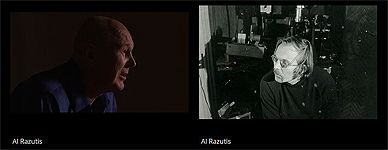
HOME PAGE:
Al
Razutis - Visual Alchemy







![(page 320) -- C.G. Jung, Psychology And Alchemy
2nd Edition, pdf [ page number ] from this source:
https://www.jungiananalysts.org.uk/wp-content/uploads/2018/07/C.-G.-Jung-Collected-Works-Volume-12_-Psychology-and-Alchemy.pdf](images/0-alchemy4-med.jpg)

